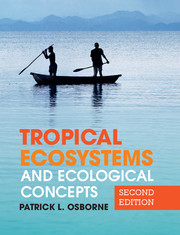Book contents
- Frontmatter
- Contents
- Preface
- Abbreviations and units
- Chapter 1 The tropical environment and climate
- Chapter 2 Dry, hot deserts and environmental factors
- Chapter 3 Grasslands and primary production
- Chapter 4 Savanna and population dynamics
- Chapter 5 Lakes, energy flow and biogeochemical cycling
- Chapter 6 Rivers, floodplains and estuaries
- Chapter 7 Wetlands and succession
- Chapter 8 Tropical rain forests and biodiversity
- Chapter 9 Mountains, zonation and community gradients
- Chapter 10 Mangroves, seagrasses and decomposition
- Chapter 11 Coral reefs and community ecology
- Chapter 12 Islands, archipelagos, biogeography and evolutionary ecology
- Chapter 13 Cities and human ecology
- Glossary
- References
- Index
- References
Chapter 11 - Coral reefs and community ecology
Published online by Cambridge University Press: 05 June 2012
- Frontmatter
- Contents
- Preface
- Abbreviations and units
- Chapter 1 The tropical environment and climate
- Chapter 2 Dry, hot deserts and environmental factors
- Chapter 3 Grasslands and primary production
- Chapter 4 Savanna and population dynamics
- Chapter 5 Lakes, energy flow and biogeochemical cycling
- Chapter 6 Rivers, floodplains and estuaries
- Chapter 7 Wetlands and succession
- Chapter 8 Tropical rain forests and biodiversity
- Chapter 9 Mountains, zonation and community gradients
- Chapter 10 Mangroves, seagrasses and decomposition
- Chapter 11 Coral reefs and community ecology
- Chapter 12 Islands, archipelagos, biogeography and evolutionary ecology
- Chapter 13 Cities and human ecology
- Glossary
- References
- Index
- References
Summary
Coral reefs rival tropical rain forests as the most species-rich communities and they support large populations of fish and other animals through very high rates of biological productivity. However, tropical reefs are typically found in nutrient-poor, shallow, coastal areas. How do these systems maintain such high levels of biological productivity? How do so many species coexist? We will see that biotic interactions on coral reefs are extraordinarily intricate, and indeed, that reefs arise through a close association between animals and algae.
Community ecology is concerned with questions such as: how and why are intricate relationships between species maintained? How do these systems respond to disturbance? Why do some communities have so many species? What determines the relative number of plants, herbivores and carnivores? We have considered how communities change along spatial gradients (see section 9.7), looked at how a community might change through time (succession) in chapter 7 and studied changes in community structure that occur following the creation of a gap in a rain forest (see section 8.15). Why coral reefs and rain forests have so many species is one of the challenging questions community ecologists have tried to answer. We discussed species diversity in chapter 8 as it applies to tropical rain forests, and will see in this chapter that many of the mechanisms used to explain how so many species coexist in a rain forest also apply to coral reefs.
- Type
- Chapter
- Information
- Tropical Ecosystems and Ecological Concepts , pp. 358 - 394Publisher: Cambridge University PressPrint publication year: 2012



